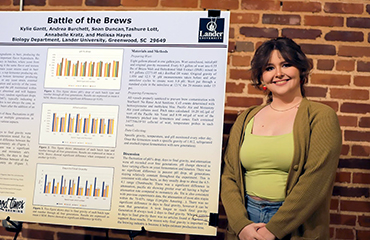
A microbiology class at Lander University can say “cheers” to the nation’s rapidly growing, competitive craft beer industry and know that their research is part of that success.
The average consumer probably has little knowledge of the intense research that goes into the brewing of craft beers and other beverages. But 16 students in the Biology 421 class at Lander spent the fall 2022 semester working with their faculty member Dr. Melissa Hayes, a Lander assistant professor of biology, and AnnaBelle Kratz, cellar manager of Good Times Brewing, to study the impact of wort pH on yeast kinetics. Their research ultimately led to the development of a new Bearcat Brew for Good Times’ customers.
Their findings, recently released at a scientific poster session at Good Times Brewing for Lander faculty and the community, revealed the intricacies of brewing beer.
Wort is the “beer starter.” It’s a liquid containing sugars that will be fermented by yeast. The process ultimately yields alcohol.
Hayes said the study of yeast kinetics includes the duration of fermentation (number of days to final specific gravity), temperature, pH of the initial wort (how acidic or basic the liquid is) and the final beer product, as well as the “harvest parameters,” including yield, cell count, and viability.
“These parameters were measured during and after fermentation over multiple batches,” Hayes said. “The study helped to answer a beer industry-wide concern over what can cause the variation in beer quality from batch to batch and also led to understanding the microbiology of why this happens.”
For Kratz, the decision to involve Lander’s science students was practical. “Brewing beer is all science. There is no way of getting around it.”
Kratz said the experiment, “in particular, was about pH for the yeast. Yeast is the life source for beer. We wanted to know how changes in the pH will affect the yeast over time.”
At Good Times and other breweries, yeast is re-used and changed over time depending on how the yeast performs in the fermentation process. The impact of wort pH on yeast can affect the taste of a beer, Kratz said.
Hayes said the collaboration gave her microbiology students the opportunity to learn scientific techniques that they may encounter in future studies or careers. “In this case, it went from an academic dimension to how our work could impact a local brewery. For a business, it’s not easy to maintain consistent taste and quality among the batches of beer. Our research helped answer some of those questions.”
Ethan Fowler, a senior from Conway, was among the students discussing their research posters, “It was really exciting to learn about the craft beer industry. Our science wasn’t focused on a life-or-death situation, but on science in the workplace,” he said.
Fellow student Zach Branham, a senior from Greenville, agreed. “It was fun to see how our work directly relates to something we could do after Lander.”
Branham is right: The rapid growth of the craft beer industry has created a market for science graduates with degrees in microbiology, chemistry, fermentation and other related disciplines.
“We don’t always have opportunities for this type of hands-on research. It was very exciting to be part of this work,” said Kayla Freeland, a senior from Charleston.
The class was a perfect fit for Andrea Burchett, of Great Falls, who will graduate in May. She plans to attend graduate school to study food microbiology. “The experience was fun and practical. We were working with a brewery. This was not basic microbiology. We’ll be out in the world very soon working with other microbiologists.”
Working with Lander was a win-win for students and the brewery, Kratz said. “They gained real-world experience. They could see how what they are studying has an impact on business, and we were able to use those research findings.”
Good Times Brewing is offering the new Bearcat Brew at its business on Maxwell Avenue in Greenwood. In the future, the brew also will be offered in area retail establishments.